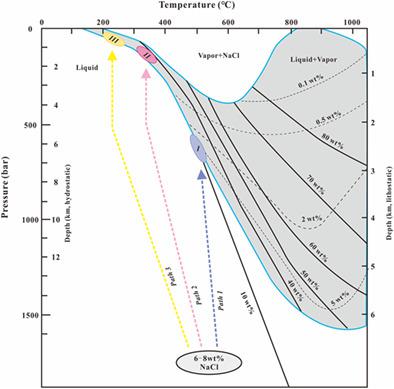当前位置:
X-MOL 学术
›
Geolog. J.
›
论文详情
Our official English website, www.x-mol.net, welcomes your feedback! (Note: you will need to create a separate account there.)
Genesis and fluid evolution of the Yuku porphyry Mo deposit, East Qinling orogen, China
Geological Journal ( IF 1.8 ) Pub Date : 2021-06-03 , DOI: 10.1002/gj.4191 Liwei Xue 1 , Gongwen Wang 1 , Yangsong Du 1 , Yi Cao 1
Geological Journal ( IF 1.8 ) Pub Date : 2021-06-03 , DOI: 10.1002/gj.4191 Liwei Xue 1 , Gongwen Wang 1 , Yangsong Du 1 , Yi Cao 1
Affiliation

|
The Yuku is a large porphyry Mo deposit (1.5 Mt at 0.12% Mo) in the Luanchuan ore district of the East Qinling orogen, central China. The economic Mo ore bodies occur as veins, veinlets, and disseminated ore and are developed mainly within the late Mesozoic Yuku porphyritic granite. Molybdenum mineralization is generally associated with potassic and phyllic alteration. Hydrothermal processes in the Yuku deposit are divided into four stages: (I) a quartz–K-feldspar–biotite ± pyrite stage, (II) a quartz–molybdenite ± pyrite ± K-feldspar ± sericite stage, (III) a quartz–polymetallic sulphide stage, and (IV) a calcite ± quartz ± fluorite ± pyrite stage. The fluid evolution during these hydrothermal stages was constrained through systematic investigation of fluid inclusions (FIs) and H−O isotopes. Four types of primary or pseudosecondary FIs were recognized in hydrothermal quartz and calcite: two-phase liquid-rich inclusions (L-type), two-phase vapour-rich inclusions (V-type), halite-bearing (hypersaline) inclusions (H-type), and three-phase CO2-bearing inclusions (C-type). FIs within Stages I–IV have homogenization temperatures of 375 to >550, 297–400, 198–298, and 149–188°C, with salinities of 0.53–13.18, 0.35–40.23, 5.11–11.81, and 5.71–9.73 wt% NaCl equiv., respectively. In Stage I, coexisting vapour-rich (V-type) and liquid-rich (L-type) FIs have similar homogenization temperatures (488 to >550°C) and distinct salinities, indicating fluid boiling during the formation of quartz–K-feldspar–biotite veins at a pressure of 550–700 bar and a lithostatic depth of 2.3–2.8 km. In Stage II, FIs in quartz were also trapped under boiling conditions, as evidenced by coexisting hypersaline H-type (34.13–40.23 wt% NaCl equiv.) and low-salinity V-type (0.35–2.24 wt% NaCl equiv.) inclusions, which formed at temperatures of 309–361°C and hydrostatic depths of 1.0–2.0 km, equivalent to pressures of 100–200 bar. During Stage III, the ore-forming fluids were cooler (198–298°C) and more dilute (5.11–11.81 wt% NaCl equiv.) due to the involvement of meteoric water, with minimum trapping pressures estimated at <100–150 bar, corresponding to a hydrostatic depth of <1.0 km. In Stage IV, temperatures decreased further to 149–188°C, with lower salinities (5.71–9.73 wt% NaCl equiv.), indicating a post-ore fluid stage. These data suggest that the mineralizing fluids forming the Yuku Mo deposit changed from early moderate- to low-salinity CO2-rich fluids in the H2O–NaCl–CO2 system that formed at high temperature and pressure, to late H2O–NaCl low-salinity fluids that formed at low temperature and pressure. H−O isotopic compositions indicate that the mineralizing fluids had a dominantly magmatic signature but were diluted by meteoric waters. Combining our integrated analysis of the fluid evolution and deposit geology, we propose that fluid boiling and fluid–rock interaction, including intensive potassic alteration, changed the salinity and triggered CO2 escape, leading to a decrease in fO2 and an increase in the acidity of the ore-forming fluids, which ultimately controlled the deposition of molybdenite in the Yuku Mo deposit.
更新日期:2021-08-04



























 京公网安备 11010802027423号
京公网安备 11010802027423号